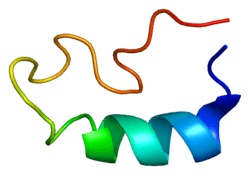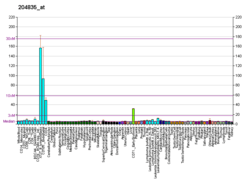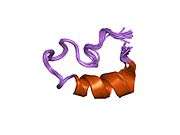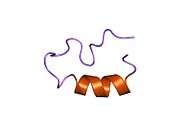DNA polymerase alpha catalytic subunit
DNA polymerase alpha catalytic subunit is an enzyme that in humans is encoded by the POLA1 gene.[3]
Function
Pol α has limited processivity and lacks 3′ exonuclease activity for proofreading errors. Thus it is not well suited to efficiently and accurately copy long templates (unlike Pol Delta and Epsilon). Instead it plays a more limited role in replication. Pol α is responsible for the initiation of DNA replication at origins of replication (on both the leading and lagging strands) and during synthesis of Okazaki fragments on the lagging strand. The Pol α complex (pol α-DNA primase complex) consists of four subunits: the catalytic subunit POLA1, the regulatory subunit POLA2, and the small and the large primase subunits PRIM1 and PRIM2 respectively. Once primase has created the RNA primer, Pol α starts replication elongating the primer with ~20 nucleotides.
In addition to its role during DNA replication, POLA1 plays a role in type I interferon activation. The POLA1 gene was found to be the site of a mutation resulting in X-linked reticulate pigmentary disorder. This leads to altered mRNA splicing and decreased expression of POLA1 protein to a level that does not impair DNA replication. The reduction in POLA1 expression is accompanied by marked reduction in cytosolic RNA:DNA hybrid molecules and a concomitant hyperactivation of the IRF pathway, with consequent overproduction of type I interferons.[4]
Interactions
DNA dependent polymerase alpha (Pol α) has been shown to interact with Retinoblastoma protein,[5] PARP1[6] and RBMS1.[7]
See also
References
- ↑ "Human PubMed Reference:".
- ↑ "Mouse PubMed Reference:".
- ↑ "Entrez Gene: POLA1 polymerase (DNA directed), alpha 1".
- ↑ Starokadomskyy P, Gemelli T, Rios JJ, Xing C, Wang RC, Li H, Pokatayev V, Dozmorov I, Khan S, Miyata N, Fraile G, Raj P, Xu Z, Xu Z, Ma L, Lin Z, Wang H, Yang Y, Ben-Amitai D, Orenstein N, Mussaffi H, Baselga E, Tadini G, Grunebaum E, Sarajlija A, Krzewski K, Wakeland EK, Yan N, de la Morena MT, Zinn AR, Burstein E (2016). "DNA polymerase-α regulates the activation of type I interferons through cytosolic RNA:DNA synthesis". Nature Immunology. 17: 495–504. PMID 27019227. doi:10.1038/ni.3409.
- ↑ Takemura M, Kitagawa T, Izuta S, Wasa J, Takai A, Akiyama T, Yoshida S (November 1997). "Phosphorylated retinoblastoma protein stimulates DNA polymerase alpha". Oncogene. 15 (20): 2483–92. PMID 9395244. doi:10.1038/sj.onc.1201431.
- ↑ Dantzer F, Nasheuer HP, Vonesch JL, de Murcia G, Ménissier-de Murcia J (April 1998). "Functional association of poly(ADP-ribose) polymerase with DNA polymerase alpha-primase complex: a link between DNA strand break detection and DNA replication". Nucleic Acids Res. 26 (8): 1891–8. PMC 147507
 . PMID 9518481. doi:10.1093/nar/26.8.1891.
. PMID 9518481. doi:10.1093/nar/26.8.1891. - ↑ Niki T, Galli I, Ariga H, Iguchi-Ariga SM (June 2000). "MSSP, a protein binding to an origin of replication in the c-myc gene, interacts with a catalytic subunit of DNA polymerase alpha and stimulates its polymerase activity". FEBS Lett. 475 (3): 209–12. PMID 10869558. doi:10.1016/S0014-5793(00)01679-3.
- Simbulan CM, Suzuki M, Izuta S, Sakurai T, Savoysky E, Kojima K, Miyahara K, Shizuta Y, Yoshida S (Jan 1993). "Poly(ADP-ribose polymerase stimulates DNA polymerase alpha by physical association". J. Biol. Chem. 268 (1): 93–99. PMID 8416979.
Further reading
- Pollok S, Stoepel J, Bauerschmidt C, Kremmer E, Nasheuer HP (2003). "Regulation of eukaryotic DNA replication at the initiation step.". Biochem. Soc. Trans. 31 (Pt 1): 266–9. PMID 12546699. doi:10.1042/BST0310266.
- Fisher PA, Korn D (1977). "DNA polymerase-alpha. Purification and structural characterization of the near homogeneous enzyme from human KB cells.". J. Biol. Chem. 252 (18): 6528–35. PMID 893425.
- Dornreiter I, Erdile LF, Gilbert IU, von Winkler D, Kelly TJ, Fanning E (1992). "Interaction of DNA polymerase alpha-primase with cellular replication protein A and SV40 T antigen.". EMBO J. 11 (2): 769–76. PMC 556510
 . PMID 1311258.
. PMID 1311258. - Coverley D, Kenny MK, Lane DP, Wood RD (1992). "A role for the human single-stranded DNA binding protein HSSB/RPA in an early stage of nucleotide excision repair.". Nucleic Acids Res. 20 (15): 3873–80. PMC 334061
 . PMID 1508673. doi:10.1093/nar/20.15.3873.
. PMID 1508673. doi:10.1093/nar/20.15.3873. - Popanda O, Thielmann HW (1992). "The function of DNA polymerases in DNA repair synthesis of ultraviolet-irradiated human fibroblasts.". Biochim. Biophys. Acta. 1129 (2): 155–60. PMID 1730053. doi:10.1016/0167-4781(92)90480-N.
- Collins KL, Kelly TJ (1991). "Effects of T antigen and replication protein A on the initiation of DNA synthesis by DNA polymerase alpha-primase.". Mol. Cell. Biol. 11 (4): 2108–15. PMC 359898
 . PMID 1848671.
. PMID 1848671. - Martelli AM, Cocco L, Manzoli FA (1991). "On the association of DNA polymerase alpha activity with the nuclear matrix in HeLa cells.". Cell Biol. Int. Rep. 15 (2): 131–40. PMID 1903085. doi:10.1016/0309-1651(91)90104-Q.
- Pearson BE, Nasheuer HP, Wang TS (1991). "Human DNA polymerase alpha gene: sequences controlling expression in cycling and serum-stimulated cells.". Mol. Cell. Biol. 11 (4): 2081–95. PMC 359896
 . PMID 2005899.
. PMID 2005899. - Matsumoto T, Eki T, Hurwitz J (1991). "Studies on the initiation and elongation reactions in the simian virus 40 DNA replication system.". Proc. Natl. Acad. Sci. U.S.A. 87 (24): 9712–6. PMC 55243
 . PMID 2175912. doi:10.1073/pnas.87.24.9712.
. PMID 2175912. doi:10.1073/pnas.87.24.9712. - Hsi KL, Copeland WC, Wang TS (1991). "Human DNA polymerase alpha catalytic polypeptide binds ConA and RCA and contains a specific labile site in the N-terminus.". Nucleic Acids Res. 18 (21): 6231–7. PMC 332486
 . PMID 2243771. doi:10.1093/nar/18.21.6231.
. PMID 2243771. doi:10.1093/nar/18.21.6231. - Wang TS, Pearson BE, Suomalainen HA, Mohandas T, Shapiro LJ, Schröder J, Korn D (1985). "Assignment of the gene for human DNA polymerase alpha to the X chromosome.". Proc. Natl. Acad. Sci. U.S.A. 82 (16): 5270–4. PMC 390549
 . PMID 2410918. doi:10.1073/pnas.82.16.5270.
. PMID 2410918. doi:10.1073/pnas.82.16.5270. - Knorre DG, Lavrik OI, Nevinsky GA (1988). "Protein-nucleic acid interaction in reactions catalyzed with DNA polymerases.". Biochimie. 70 (5): 655–61. PMID 3139084. doi:10.1016/0300-9084(88)90250-7.
- Nishida C, Reinhard P, Linn S (1988). "DNA repair synthesis in human fibroblasts requires DNA polymerase delta.". J. Biol. Chem. 263 (1): 501–10. PMID 3335506.
- Wong SW, Wahl AF, Yuan PM, Arai N, Pearson BE, Arai K, Korn D, Hunkapiller MW, Wang TS (1988). "Human DNA polymerase alpha gene expression is cell proliferation dependent and its primary structure is similar to both prokaryotic and eukaryotic replicative DNA polymerases.". EMBO J. 7 (1): 37–47. PMC 454213
 . PMID 3359994.
. PMID 3359994. - Tsuda M, Masuyama M, Katsunuma T (1986). "Inhibition of human DNA polymerase alpha by alpha 1-antichymotrypsin.". Cancer Res. 46 (12 Pt 1): 6139–42. PMID 3490907.
- Jackson DA, Cook PR (1987). "Different populations of DNA polymerase alpha in HeLa cells.". J. Mol. Biol. 192 (1): 77–86. PMID 3820307. doi:10.1016/0022-2836(86)90465-1.
- Miller MR, Seighman C, Ulrich RG (1986). "Inhibition of DNA replication and DNA polymerase alpha activity by monoclonal anti-(DNA polymerase alpha) immunoglobulin G and F(ab) fragments.". Biochemistry. 24 (25): 7440–5. PMID 4084590. doi:10.1021/bi00346a061.
- Bensch KG, Tanaka S, Hu SZ, Wang TS, Korn D (1982). "Intracellular localization of human DNA polymerase alpha with monoclonal antibodies.". J. Biol. Chem. 257 (14): 8391–6. PMID 7045121.
- Tanaka S, Hu SZ, Wang TS, Korn D (1982). "Preparation and preliminary characterization of monoclonal antibodies against human DNA polymerase alpha.". J. Biol. Chem. 257 (14): 8386–90. PMID 7085672.
- Eckert KA, Kunkel TA (1993). "Fidelity of DNA synthesis catalyzed by human DNA polymerase alpha and HIV-1 reverse transcriptase: effect of reaction pH.". Nucleic Acids Res. 21 (22): 5212–20. PMC 310639
 . PMID 7504813. doi:10.1093/nar/21.22.5212.
. PMID 7504813. doi:10.1093/nar/21.22.5212.




